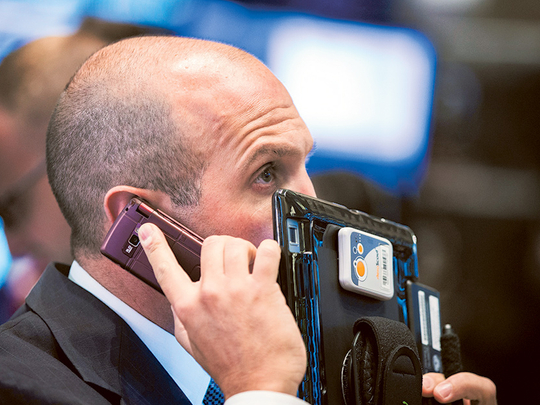
Black Monday was not a fun time to trade stocks in New York.
China and Japan, the world’s second and third biggest equity markets, had closed about 8 per cent and 6 per cent lower in the early hours, and red ink had spilt across every major platform in Europe. Before the opening bell some pundits were muttering about carnage on Wall Street.
But clients of iSentium — about a dozen hedge funds — were urged to be bold. According to the Twitter-mining machines built by the New York-based company, the S&P500 index was set for a rebound on the morning of August 24, once the opening skirmishes were out of the way.
The software had examined the language of hundreds of thousands of stock-related tweets and predicted that the prevailing mood in the market that day would be more positive than negative. Hence the recommendation that investors buy the SPDR S&P500, an exchange-traded fund that tracks the index.
Gautham Sastri, chief executive and the biggest investor in iSentium, has been putting his money where his mouth is. Every day he uses a pot of his own cash to buy or sell the index at 9:31am, depending on whether the signal is bullish or bearish, then exits the position a few minutes before the closing bell.
By mid-August, he says he was up 17 per cent for the year — about 12 times better than the S&P. On Black Monday he made 2.5 per cent.
“In a way, it’s the dumbest strategy there is,” says Sastri. “But it works.”
His company is small: 13 employees, on track to turn over about $1.8 million this year. But it is in the forefront of an emerging breed of finance-focused companies trying to extract value from the din of Twitter’s 316 million active users.
Dataminr, a six-year old outfit set up by a trio of former Yale University classmates, trawls the platform to unearth what it calls “actionable alerts” for traders, reporters and government agencies. Selerity, founded and backed by ex-Thomson Reuters executives around the same time, also scans for market-moving news — most notably in April, when it picked up a mistakenly-released earnings report from, ironically, Twitter.
Others include Social Market Analytics, Psych Signal and Market Prophit.
Bloomberg and Thomson Reuters, too, offer filtered data from Twitter and StockTwits, which streams financial information in the same 140-character format, on their professional platforms.
They are all part of “a rapidly evolving ecosystem,” as Stephen Morse, New York-based head of global financial data products at Twitter, puts it. The first wave of early adopters was hedge funds and high-frequency traders trying to harness the data themselves, connecting directly to Twitter’s application programming interface, he says.
Now specialists such as iSentium are doing the work for them.
According to Sastri, a serial entrepreneur who made a fortune selling computer hardware, iSentium stands out because it predicts rather than reacts, using a patented language processing technology developed with linguists to assign a sentiment score to each tweet.
The scores are aggregated to create daily directional indicators for stocks and indices, and real-time sentiment feeds.
The system is not perfect, so iSentium employs a full-time staffer to randomly review scores on individual tweets on about 8,500 stocks and ETFs. Four times out of five, Sastri says, the robots get the feeling right.
The rest of the time they are misled by nuance, sarcasm, ambiguity or spammers. “My premise has always been, if you can correctly interpret what the mob is saying, “alpha [market-beating returns] should be a natural side-effect”.
He contrasts what iSentium does with the technical analysis that lies at the heart of a lot of research on Wall Street. “You are taking something that has already happened — namely price — then presuming that something predictable is going to emerge from it. Whereas, if you correctly derive sentiment, you have a pretty good chance of knowing what is going to happen.”
Success is far from guaranteed. As noted by a recent report by Gnip, a Twitter analytics service, the finance industry has been slower than others to harness the power of social media. It was only two years ago that many traders awoke to the power of tweets to move prices, when a message from Carl Icahn, the activist investor, added about $12 billion to the market capitalisation of Apple.
But someone needs to try to make sense of the “giant utilities” of Facebook and Twitter, says Sastri, which together supply about 90 per cent of the world’s social media content.
“Their revenue model is to create more content, called advertising, to make micro-cents per eyeball. What we want to do is to tell you what it means.”
Raised and educated in Hyderabad, Mr Sastri arrived in the US in the early 1980s to study at the Seismic Acoustics Laboratory at the University of Houston. His papers on computational algorithms for oil and gas exploration landed him a job working for a branch of the US Navy in Perth, Australia, looking for Russian submarines.
After a spell at NEC he set up Maximum Throughput, supplying racks of servers to clients ranging from the Los Alamos nuclear laboratory to Goldenpalace.com, an online casino. He went on to found Terrascale Technologies, which developed a niche selling cloud storage to the “kind of people [Edward] Snowden complains about. They were basically doing text analysis, proving that by reading through people’s stuff using computers, you can discern their intent and predict their actions.”
Sastri sold it in 2006, leaving after a couple of years. “I’m an entrepreneur, I either like to lead or get out.”
He invested in Montreal start-up Keenkong, which — in some ways like the US National Security Agency — scanned social media to try to gauge the effectiveness of companies’ marketing spend. Keenkong had a talented team of linguists led by Anna Maria di Sciullo, a professor at the University of Quebec who had studied under Noam Chomsky at MIT, but it had not shipped a product. Within two years Sastri had taken over and booted out almost everyone but the linguists, directing them to apply the science to the stock market.
“With marketing, there is a nebulous connection between cause and effect,” he says. “With trading, you either made money or you didn’t.”
The company, renamed iSentium, is now eyeing other areas such as political polling, and has started to talk to campaigns and news agencies. “Politicians are just ticker symbols, if you think about it,” says Sastri. “Their stock goes up or it goes down, and it’s driven by the same factors that drive stock prices — perception, trustworthiness, momentum.”
Financial Times












